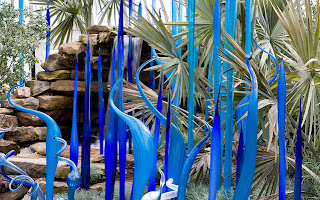
Being in the midst of nature or seeing other artist’s work can be very inspiring for me. Who could argue with having both at the same venue? Therefore, last week we ducked out of the studio for a day to go visit Phipps Conservatory. The gardens are currently filled with larger-than-life glass sculptures and bowls by Dale Chihuly and his glassmaking team. These abstract natural forms with their exquisite, energetic colors added unbelievable beauty to the gardens.
Phipps describes this exhibit…“Right here in our lush and inspiring gardens, Chihuly has planted an exhibit of his wild and wonderful creations -- and the result is simply breathtaking. Known for his flamboyant colors, monumental sculptures and outdoor displays, Chihuly is also famous for his creative collaborations. Inspired by our Victorian glasshouse – one of the oldest in North America, this pioneer in the use of glass has joined with our horticulturalists and landscape designers to create a dazzling fusion of art and nature.” The show lives up to this description and much more.
I don’t think I’ve ever had a presentation of art touch me the way this show did. One of the thoughts that continually ran through my head was how Chihuly was able to use his glass art to supplement the already superb environment of the gardens. Even with the exquisite coloring of the glass the art always seemed to mingle happily with the environment. The art did not scream for attention. The plants were not shouting out because they were being ignored. The surrounding architecture was like the perfect packaging. This concept relates to our worship spaces. When wearing stoles, hanging worship banners, or even adding a flower arrangement to the chancel I believe it should only be done to enhance the worship that will occur in the space. These artistic expressions are best when they awaken us to God’s presence and not call attention to themselves. I appreciate how the Presbyterian Church phrases this concept in their Book of Order; “artistic expressions should evoke, edify, enhance, and expand worshipers’ consciousness of the reality and the grace of God.”
If you are in the Pittsburgh, PA area prior to this exhibit closing on November 11, 2007 you would be amiss not to treat yourself to the experience of a visit to the Chihuly exhibit at Phipps. In the meantime think about the space you worship in and encourage artists in their offerings. Lastly, see if you recognize some lines and shapes that echo the work of Chihuly at Phipps in new stoles designs at Carrot Top Studio!
You can learn more about Phipps at http://www.phipps.conservatory.org .




